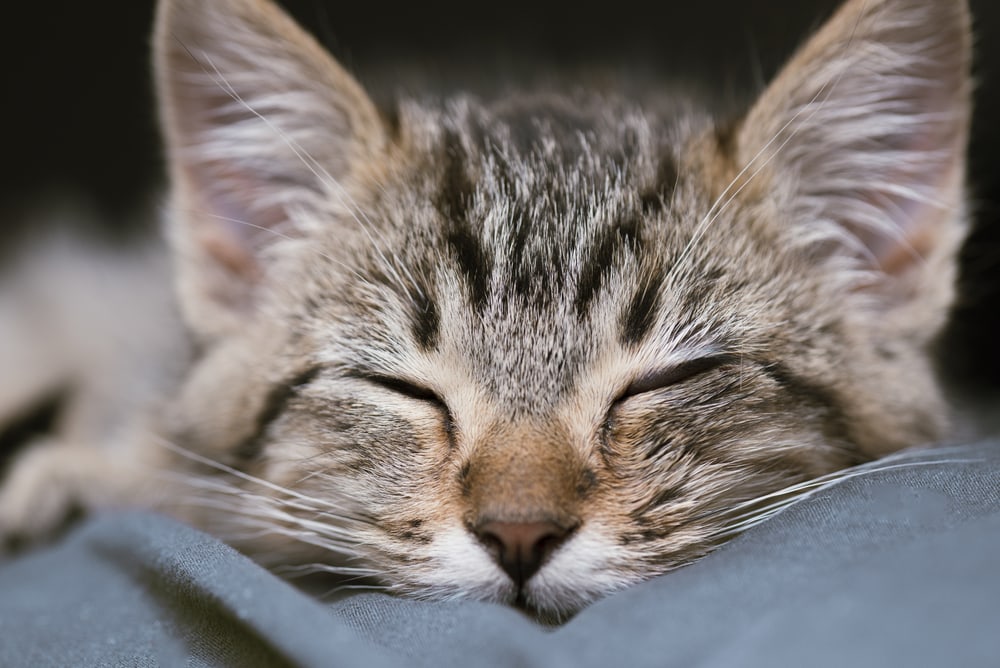How to Tell if a Cat Has a Fever? 10 Vet-Reviewed Signs & Symptoms
Updated on
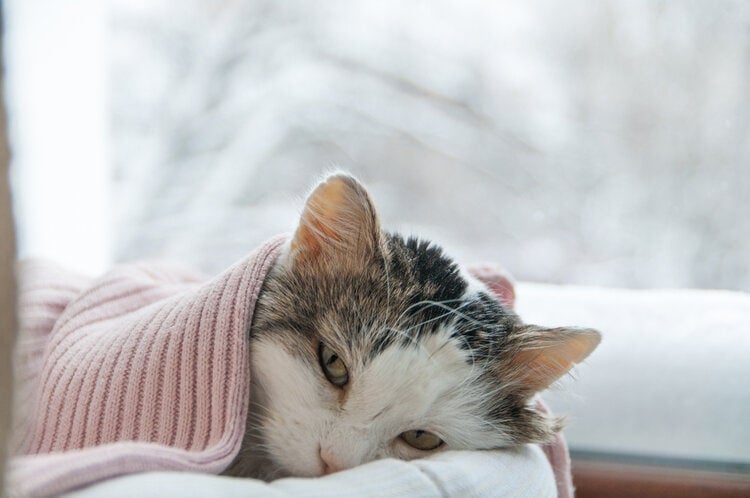
Click to Skip Ahead
A cat is considered to have a fever if its temperature rises above 102.5 degrees Fahrenheit and although fevers occur to help the body fight off infection, fevers that reach 106 degrees Fahrenheit or higher can cause serious damage in cats.
Below we will not only learn about how to tell if your cat has a fever, but we will also look at the underlying causes of fever in cats, how to take their temperature, and the best way to care for your sick kitty.
The 10 Signs to Identify a Fever in Cats
No owner wants to see their beloved pet fall ill with a fever, after all, we know how miserable being feverish can make you feel. There are some signs and symptoms to be on the lookout for that can help you identify the possibility of a fever in your cat.
1. Loss of Appetite
While a loss of appetite can have many underlying causes that are not related to a fever, it is a telltale symptom of a fever as well. If you notice your cat is refusing food, it is best to reach out to the veterinarian to help determine the root cause.
2. Lack of Interest in Normal Behavior and Activities
If your typically playful cat seems down in the dumps and has no interest in its normal activities, this is a possible sign of a fever and/or illness of some sort. Each cat is an individual and exhibits certain behavioral traits and daily activities, if you notice a drastic change, don’t hesitate to reach out to your veterinarian.
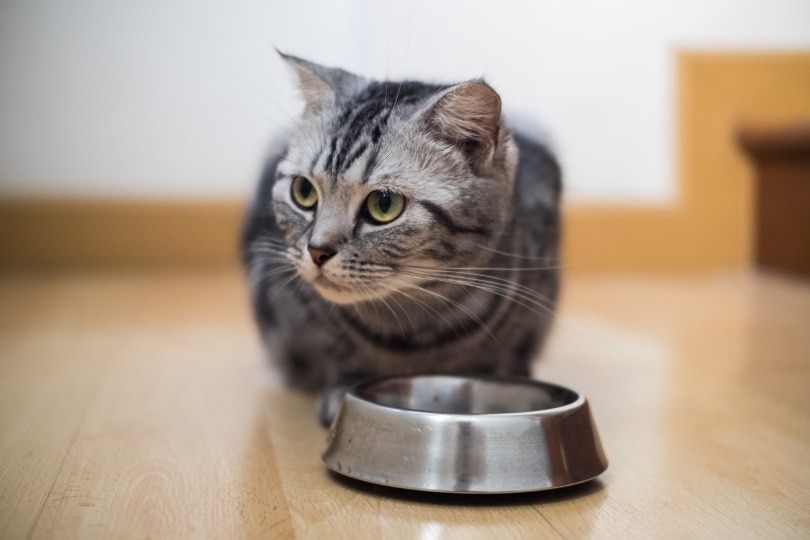
3. Lethargy
Fevers are the body’s way of fighting off infection, whether it be viral or bacterial by activating the body’s immune system and raising the internal body temperature. Lethargy is a very common symptom when one becomes feverish. If your cat has a noticeable lack of energy, this could be a sign they have a fever.
4. Decrease in Grooming
Cats are self-groomers and normal, healthy cats will groom themselves frequently. If they are experiencing a fever and feeling under the weather, it is not abnormal for them to decrease their grooming activities so they may look a little unkempt and rugged.
If you need to speak with a vet right now but can’t get to one, head over to JustAnswer. It’s an online service where you can talk to a vet in real time and get the personalized advice you need for your pet — all at an affordable price!
5. Drinking Less Frequently
Cats that are experiencing a fever are not only likely to have a decrease in appetite but will also drink less frequently as well. Dehydration can happen easily, so it is very important to keep a watchful eye on your cat and ensure they are getting a healthy amount of fluids. If you notice a decrease in thirst and drinking, contact your veterinarian.
6. Keeping Distance and/or Hiding
Cats are survivalists by nature. When they are not feeling well, it is very common for them to find a safe and secure hiding place when they are feeling unwell. In the wild, illness makes them vulnerable to falling prey to larger predators. When they are not feeling in tip-top shape, you can expect them to slink away into a hiding place and keep their distance from everyone in the household.
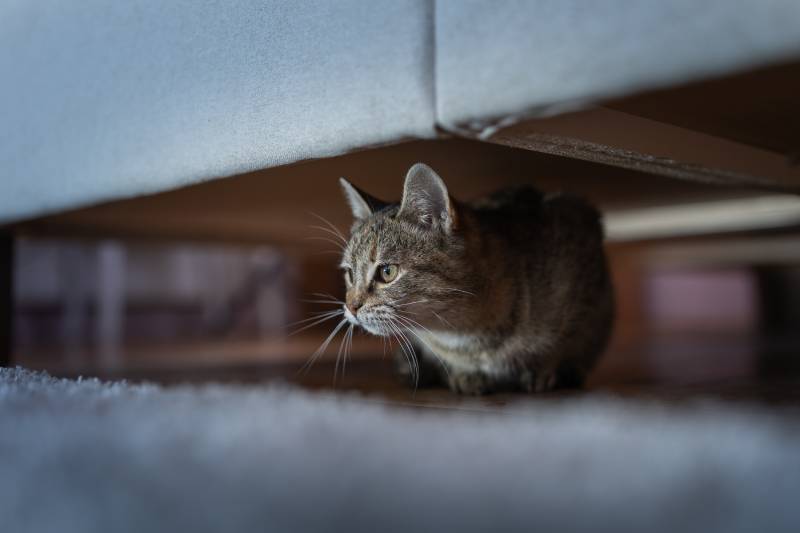
7. Chills/Shivering
If you notice your cat is shivering, this could be a telltale sign of a fever. Just like in humans, chills are a typical fever symptom in cats.
8. Rapid Heart Rate
A cat’s resting heart rate is higher than that of a human, falling between 120 and 160 beats per minute. Fever can cause a rapid heart rate though and if you notice your cat’s pulse is at 240 beats per minute or higher, it is time to contact your veterinarian for further advice.

9. Rapid Breathing
Rapid heart rate and rapid breathing can go hand-in-hand, and both can result from your cat has a fever. Rapid breathing is always a cause for concern and if you notice your cat is breathing rapidly and/or panting, you need to contact your veterinarian so the underlying cause can be determined as soon as possible.
10. Thermometer Reads 102.5 degrees Fahrenheit or higher
The full proof way of finding out if your cat is running a fever is by taking their temperature. Using a pediatric thermometer and taking the temperature rectally will yield the best results. If your cat’s temperature is 102.5 degrees Fahrenheit or higher, your cat has a fever. If their temperature is 106 degrees Fahrenheit or higher, severe organ damage can occur, thus veterinary intervention is needed immediately.
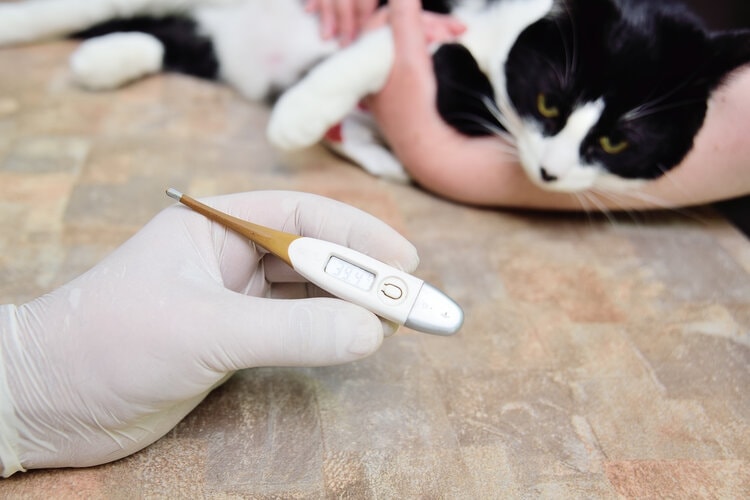
How to Take a Cat’s Temperature
As mentioned above, the only way to know for certain that a cat has a fever is by taking its temperature. This can be done at the veterinary clinic or home using a pediatric rectal thermometer.
For safety reasons, it is recommended to use a digital thermometer rather than one made of glass. If you do not have a thermometer on hand, one can easily be purchased at your local pharmacy.
It is important to note that not everyone will feel comfortable taking a cat’s temperature. If you would prefer not to, simply call the veterinarian and the staff will be able to check your cat’s temperature. As a rule, if you are concerned enough to check their temperature, you should be contacting your veterinarian anyway. For those that are willing to check for themselves, here are some tips on checking your cat’s temperature at home.
What You Will Need
- Digital Thermometer (recommended)
- Lubricant
- Alcohol
- Paper Towels
- Cat Treats
Step-By-Step Guide to Taking a Cat’s Temperature
- It is highly recommended that you have someone available to help you restrain your cat. Having a helping hand can prevent scratches, bites, and potential injury to you and will also help ensure your cat’s safety during the process. If you are alone, make sure your cradle them closely and are certain they are unable to wriggle out of your grasp.
- Coat the tip of the thermometer will a lubricant, such as petroleum jelly. Never insert a thermometer that is not lubricated, this can make the experience very uncomfortable and even painful for your cat and it will be much harder to keep them still.
- Gently lift their tail and slowly and delicately insert the thermometer into the anus. Twisting the thermometer from side to side can help the muscles relax. Insert the thermometer approximately one inch into the rectum and keep it in place until you hear the beep indicating it is complete.
- Slowly remove the thermometer once you hear the beep and observe the reading. Remember, a temperature above 102.5 degrees Fahrenheit is considered a fever in cats.
- Clean the thermometer with alcohol swabs or a paper towel that has been saturated with alcohol.
- Give your cat lots of praise and offer them a treat if they are willing to take it. This is not a comfortable process for your cat so do not be discouraged if they do not accept the treat. In addition, if a fever is present your cat may not have much of an appetite.
Causes of Fever in Cats
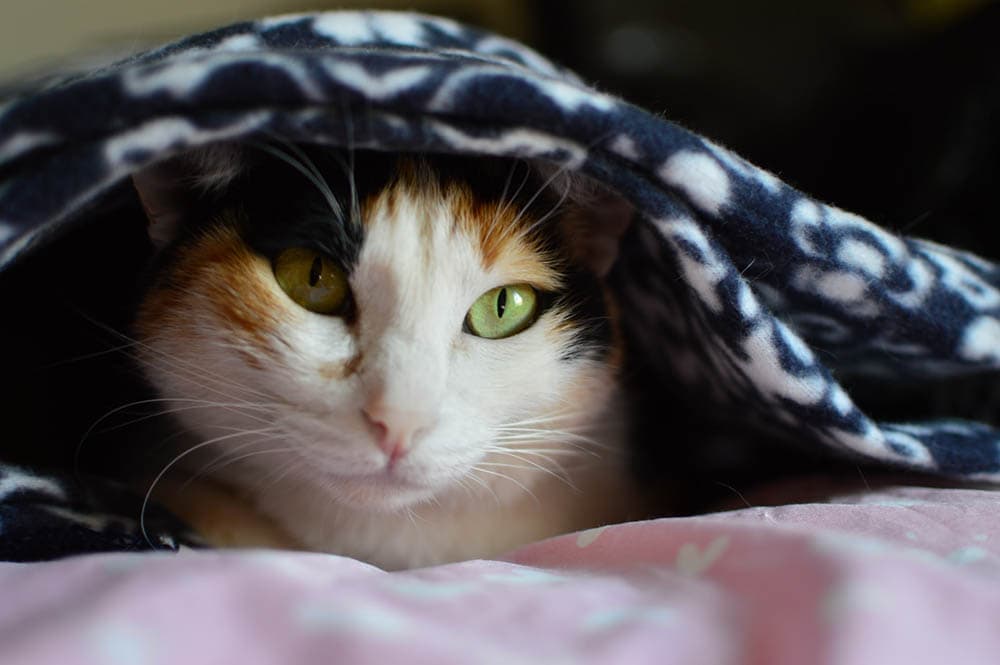
A fever can be caused by many underlying conditions, and you will need to get your cat to the veterinarian so that they can thoroughly examine your cat and do the necessary tests for proper diagnosis. Fevers in cats are typically caused by the following:
- Bacterial and viral infections
- Fungal infection
- Internal injury
- Trauma
- Parasites
- Autoimmune disease
- Certain medications
- Tumors
- Immune-mediated inflammatory disease
- Poisoning
- Metabolic disorders
- Endocrine disorders
When to Call the Veterinarian
Any time your cat is exhibiting unusual symptoms that are outside their normal behavior, it is best to contact your veterinarian for advice. They may advise you to keep a close eye on the symptoms or they may suggest that you make an appointment to have them checked out.
If your cat has a fever above 104 degrees Fahrenheit for more than 24 hours, this warrants a visit right away. Remember that fevers over 106 degrees Fahrenheit can cause serious damage to a vital organ, including the brain, and this is considered an emergency. If your veterinary office does not see patients after hours, it’s important to have emergency veterinary services information close by.
The veterinarian will likely perform tests and complete a physical examination. You will be asked a series of questions about your cat’s overall health, when symptoms began, what you have observed, and more. Once the underlying cause is determined, your cat can be treated accordingly.
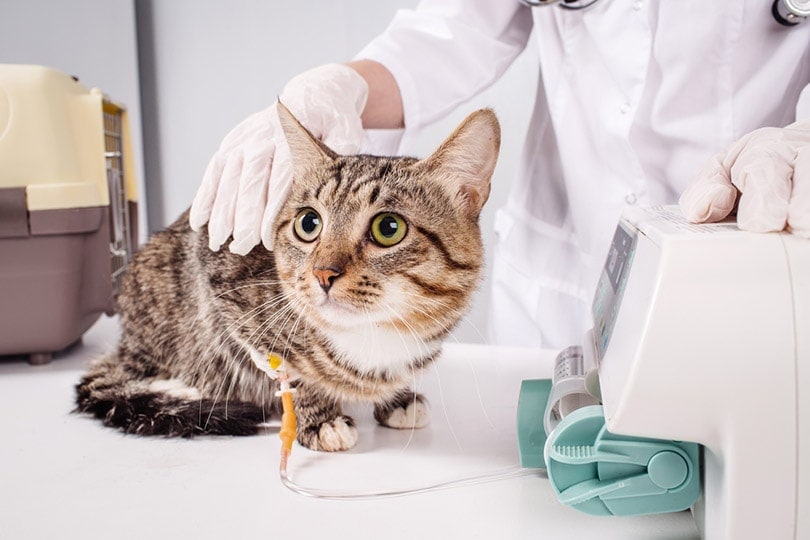
Caring for a Cat with a Fever
Never give your cat any human medicine to reduce fever. The over-the-counter medications we take to reduce fevers are toxic and potentially fatal to cats and other animals. No medication should be given to your cat without veterinary approval.
Of course, calling the veterinarian is a top priority once you determine your cat has a fever. Once they are diagnosed, your veterinarian will begin a treatment plan. For example, if a bacterial infection is determined to be the cause, your cat will likely be given antibiotics.
Dehydration is a serious concern when cats present with a fever, they may require additional fluid either orally or through an IV. Your veterinarian will give you information on how to best care for your cat at home once they determine the cause.
Final Thoughts
A fever is the body’s way of fighting off infections. While there are many symptoms associated with fevers in cats, the only way to know for sure if your cat has a fever is by taking their temperature with a thermometer.
Any time your cat has a fever or is exhibiting any symptoms associated with a fever, it is best to contact your veterinarian immediately for further instruction. Your veterinarian will be needed to properly diagnose and treat the underlying condition that is causing the fever.
Related Reads:
- How to Clean a Cat Litter Mat in 8 Simple Steps
- How to Get a Cat to Use a Cat Tree (6 Possible Ways)
Featured Image Credit: Germanova Antonina, Shutterstock






